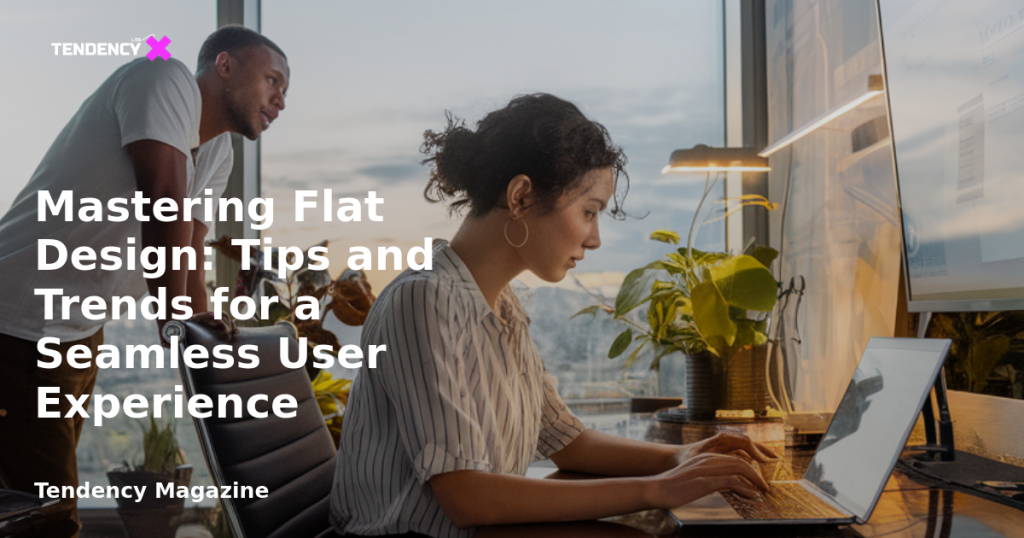Mastering Flat Design: Tips and Trends for a Seamless User Experience

Table of Contents
- What is Flat Design?
- Benefits of Flat Design
- Limitations of Flat Design
- Flat Design 2.0
- Examples of Flat Design Websites
- Tips for Implementing Flat Design
- Flat Design FAQ
What is Flat Design?
Flat design is a style that eschews the three-dimensional effects such as shadows, gradients, and textures that were prevalent in earlier digital design trends known as skeuomorphic design. Skeuomorphic design aimed to mimic real-world objects, creating a sense of depth and realism. In contrast, flat design embraces simplicity, using clean, crisp edges, ample negative space, and straightforward typography to create an intuitive user experience.
This design philosophy draws inspiration from Swiss-style graphic design, which emphasizes clarity and readability. By focusing on simplicity, flat design allows users to engage with digital content without unnecessary distractions, making it a popular choice for modern websites and applications.
Benefits of Flat Design
Flat design offers several advantages that make it appealing for both designers and users. One of its primary benefits is its ability to highlight the design’s message, allowing content to take center stage. The use of large typography and generous white space enhances readability, which is beneficial not only for users but also for search engine optimization.
Another significant advantage of flat design is its impact on website performance. By eliminating complex design elements, flat design reduces the amount of digital information that needs to be processed, resulting in faster loading times. This simplicity also ensures that design elements scale effectively across different devices and screen sizes, providing a consistent user experience on both desktop and mobile platforms.
Limitations of Flat Design
Despite its many benefits, flat design is not without its challenges. Some users, particularly those who are less familiar with digital interfaces, may find flat design less intuitive than skeuomorphic design. The lack of visual cues, such as shadows and textures, can make it difficult for some users to distinguish interactive elements, leading to potential usability issues.
Flat design can also pose challenges for users with specific needs, such as the elderly, children, or individuals with visual impairments. For these users, the absence of color differentiation and dimensionality can make navigation more difficult. As a result, designers must carefully consider these limitations and strive to create inclusive and accessible designs.
Flat Design 2.0
In response to some of the limitations of traditional flat design, a new iteration known as Flat Design 2.0 has emerged. This approach seeks to strike a balance between the minimalism of flat design and the functionality of skeuomorphic design by incorporating subtle shadows and gradients. These elements create a sense of depth and interactivity, making it easier for users to navigate digital interfaces.
Flat Design 2.0 offers a more versatile solution that retains the aesthetic appeal of flat design while addressing some of its usability challenges. By blending elements of both design philosophies, this approach provides a more comprehensive user experience.
Examples of Flat Design Websites
To better understand the application of flat design, let’s explore some examples of websites that have successfully implemented this trend:
- Goodboybob Coffee Roasters: This site utilizes a clean sans-serif typeface, high-contrast color schemes, and ample white space to create an inviting and user-friendly experience.
- NOOCI: By incorporating slight drop shadows and top-down imagery, NOOCI’s website exemplifies Flat Design 2.0, offering a visually engaging interface.
- Umanos: With bold typography and primary colors, Umanos’ website mirrors Swiss design principles, creating a striking visual hierarchy.
- Cowbird Coffee Roasters: This site employs shading effects to enhance interactivity, demonstrating the potential of Flat Design 2.0.
- Malapata Art Gallery: The use of pastel backgrounds and drop shadows allows artworks to stand out, showcasing the versatility of flat design.
Tips for Implementing Flat Design
For those looking to incorporate flat design into their digital projects, consider the following tips:
- Employ Standard UI Patterns: Use familiar interface elements, such as navigation menus and buttons, to ensure users can easily navigate your site.
- Establish a Clear Visual Hierarchy: Highlight important information with size, color, and contrast to guide users’ attention.
- Stick to the Grid: Utilize grid-based layouts to organize content effectively, improving readability and comprehension.
- Pay Attention to Contrast: Ensure sufficient contrast between text and background colors to enhance accessibility and readability.
- Utilize Subtle Animations: Introduce motion or light animations to indicate interactivity and engage users.
Flat Design FAQ
What is flat design?
Flat design is a minimalist design trend characterized by two-dimensional elements, simple typography, and high contrast. It emphasizes clarity and functionality.
Is flat design losing popularity?
Flat design remains prevalent but is evolving. Flat Design 2.0 incorporates elements of skeuomorphic design to enhance usability.
What is the opposite of flat design?
The opposite of flat design is skeuomorphic design, which mimics real-world textures and dimensions to create a sense of realism.
In conclusion, flat design offers a streamlined, efficient approach to digital design that prioritizes user experience. By understanding its benefits and limitations, designers can create engaging and accessible interfaces that cater to a wide range of users. As flat design continues to evolve, embracing new trends and technologies will ensure that digital products remain both functional and visually appealing.
2025 Tendency LTD. All rights reserved.

